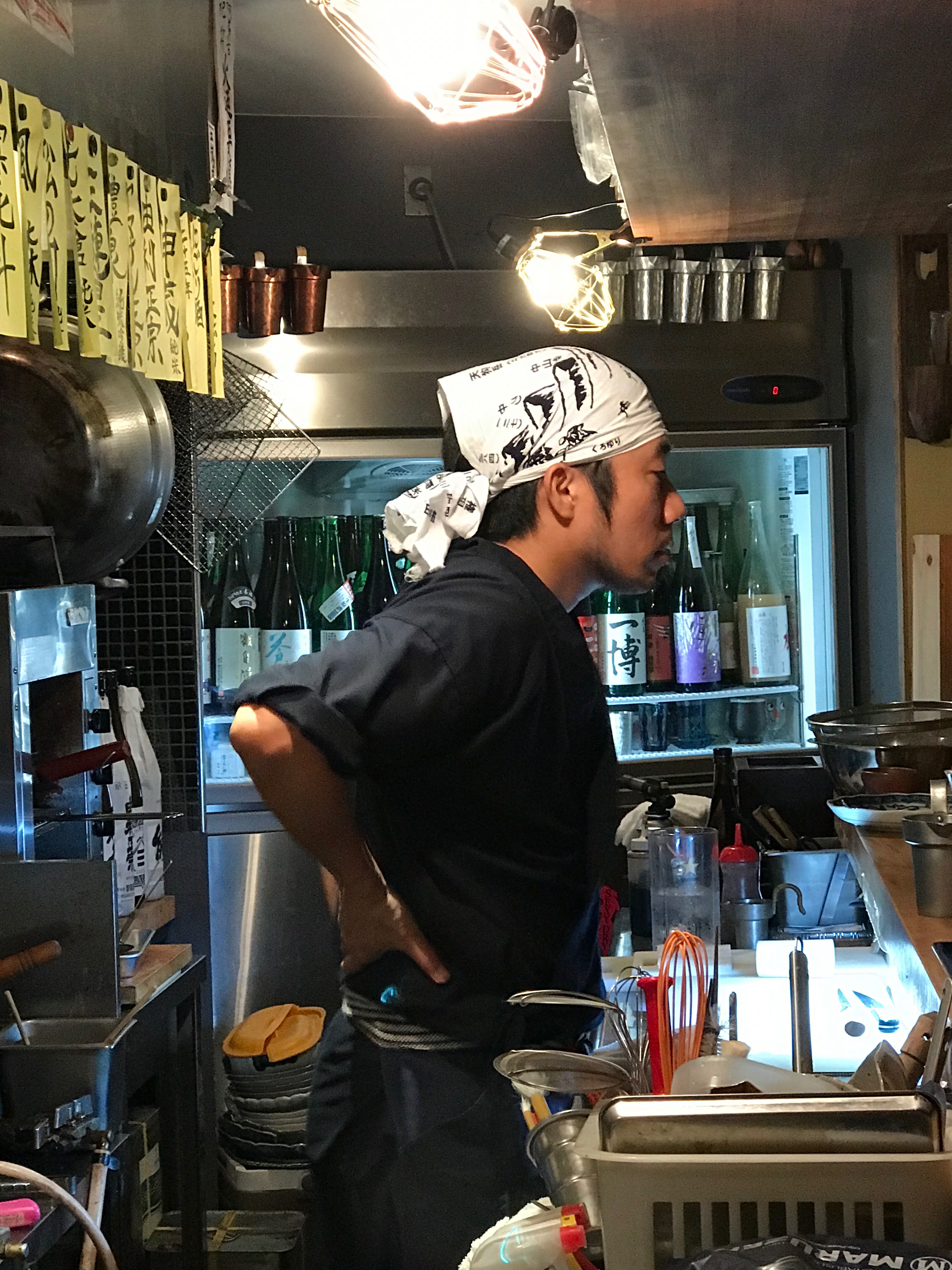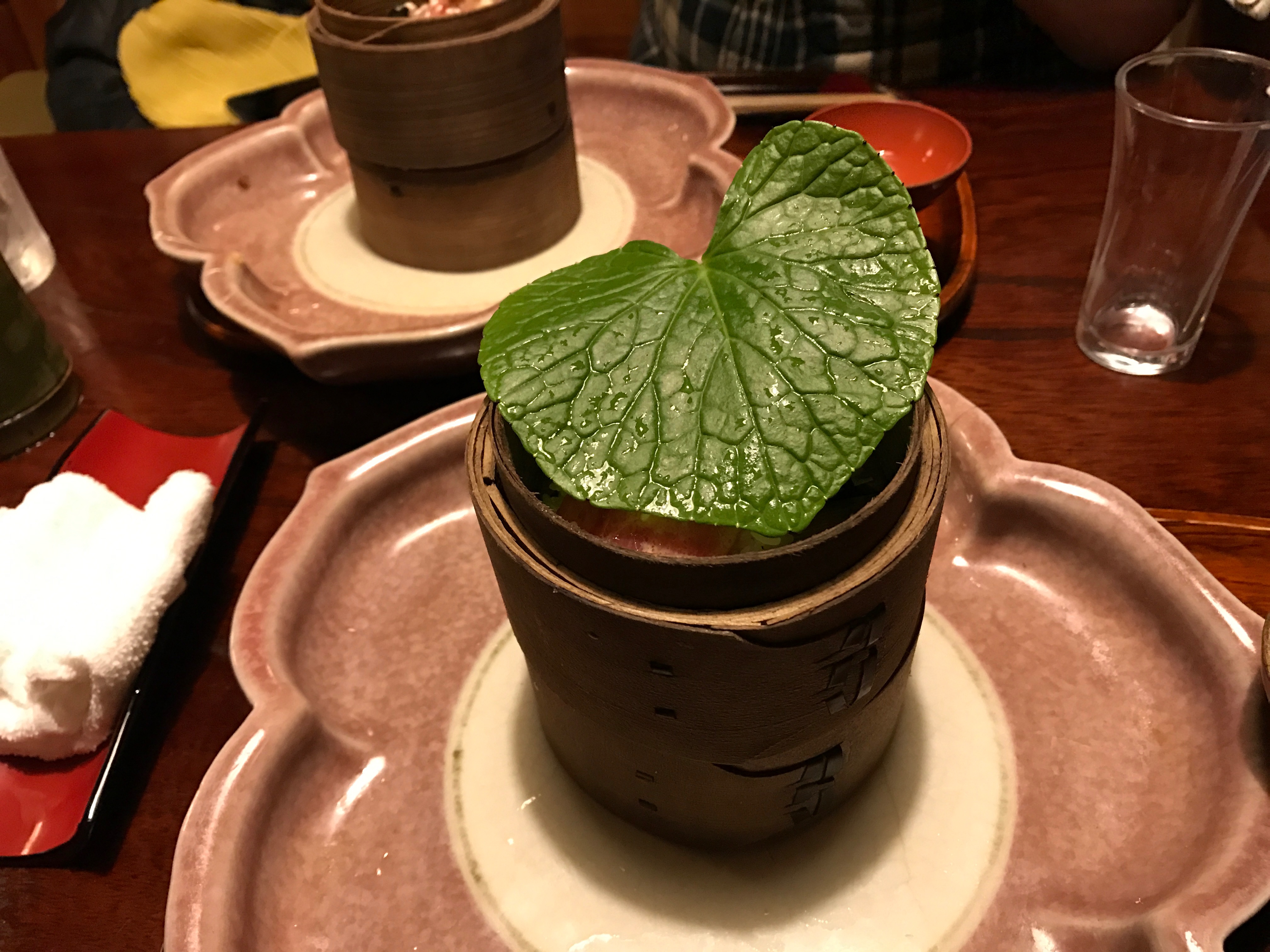Almost from the moment we set foot in Kyoto, my foodie husband is scouting for new restaurants in our neighborhood that have opened in our absence. As hyped as I am to be sure to see the most intriguing gardens, sublime temples, cool museums and Japanese design shops, he’s on the edge of his seat to reconnect with the wonders and satisfaction of eating Japanese cuisine. He’s always on alert for the next culinary attraction. It could be a new sake bar, french bakery, izakaya, ramen, soba, steak place or hamburger spot. As long as it looks promising, my husband is eager to try it. We have our food work cut out for us, and I’ve learned not to resist. I simply try them all and go along for the great ride he pulls together and congratulate him on his finds.
If the place looks complicated, he likes to see if they have an English menu available. Given one, he’ll then bemoan the fact that not all of the items available in the restaurant are represented on the English menu. I remind him that there’s no way he could eat all the items even if they were listed, but he always want to see what he might be missing. I’m always eager to follow along with his trailblazing food-related energy. By myself, I’d never put in the effort he does.
Restaurants in Japan tend to be smaller than Americans are used to. Reservations are a must, so the chef knows how much food to buy each day. Once you understand their system, you respect it. If you rely on a last minute casual walk up, you’re going to be out of luck for most serious restaurants in Japan. And it’s remarkable how many restaurants are SERIOUS! By serious, I mean chefs and underlings studying and honing their specific skills for years, always delivering to the best of their ability, constantly striving for perfection.
Tourists tend to strive to score a rez at a Michelin starred venue, but there’s really no need if it’s just a fine restaurant you want and not another notch in your belt.
We visited one restaurant that was a one man band. Our dear friend, ceramic guru Robert Yellin, shared a favorite neighborhood spot a few minutes walk away from his home near the Philosopher’s Walk, this time of year garlanded in pink. The young owner presided over the space entirely by himself, taking orders, cooking, serving and chatting when he had a moment. And doing it all brilliantly too. Note the sakes in the fridge just waiting to be savored.
The smallness of many restaurant spaces in Japan creates an intimacy among servers, chefs and patrons. There’s usually an amiable banter going back and forth among the customers, the servers and the cooks. We’re at a distinct disadvantage not speaking the language, but we quickly get swallowed up in the good spirits of all present and the welcoming smiles we are given.
Truly, we have never encountered a disgruntled waiter or a snotty host or hostess. It’s just not part of their DNA. We’ve never seen a laggard or sourpuss in sight. My interpretation is that a bad attitude is not tolerated. There is mutual respect for everyone working, no matter where they are on the kitchen totem pole and true team effort is always in evidence, allowing these places of business to hum smoothly, no matter how much seems to be going on at once. I guess egos are parked at the door.
Food in Japan is always seasonal, impeccably fresh, and beautifully presented, from a restaurant kitchen that’s scrupulously clean. It’s cooked by a chef who’s earned his chops and has probably apprenticed in his chosen speciality for many years! There’s no attitude and no pretension, only dedication to the art and skill of cooking and presenting food at its very best. It’s knowing that less is more and allowing the flavors of the food to speak for themselves, never overpowered by sauces and weird combinations of flavors. It’s respecting tradition, but also understanding its power. It’s a tradition that’s been refined for hundreds of years, and it’s best to be familiar with it if you’re preparing the food.
“The concept of shokunin, an artisan deeply and singularly dedicated to his or her craft, is at the core of Japanese culture. Japan’s most famous shokunin these days is Jiri Ono, immortalized in the documentary Jiro Dreams of Sushi, but you will encounter his level of relentless focus across the entire food industry. Behind closed doors. Down dark alleyways. Up small stairwells. Hiding in every corner of this city and country….” Rice, Noodles, Fish: Deep Travels Through Japanese Food Culture, Matt Goulding.
A small restaurant in Kyoto profiled by this fine book personifies this culture. In an unassuming small building in the far west of Kyoto along the river bank in Arashiyama, exists a wonderful restaurant, with a great soul, It’s a tough place to get a reservation. We had to wait several weeks before being given a slot of time for dinner. But what a dinner. To me, it represents the best of what I enjoy when eating out in Kyoto; a joyous unpretentious space where the love and respect for food and its seasonality is what it’s all about. Course followed course, each small and distinctive. In some instances, the courses were served on exquisite antique lacquer dishware, another psalm to the season.
But another surprise came after dinner. We were the last customers to leave. We expressed to our hosts, as best we could, how much we had enjoyed our meal. We told the owner’s daughter that this was our second time eating here. We’d liked it so much that this time we brought along a Japanese friend as a guest. Smiling broadly, the owner’s daughter approached our table. She handed my husband a card that gave him a private number to call the next time we want to eat at this restaurant. As we prepared to leave, all the staff in the restaurant gathered to say good night to us and to thank us for coming.
Our farewell was worthy of royalty, multitudes of thank – you’s and non-stop smiles, all around. The pleasure brought by the meal not to mention the business card were immeasurable and will be savored. We shall return again.
In the fall, the view from the window will reveal the colors of autumn, while this refuge reveals its subtle flavors.







Wow yum! I write on tea 🙂
https://infuzed.net/2017/05/15/the-best-start-ups-that-are-all-about-tea/
Enjoyed this!